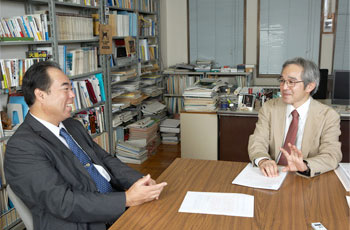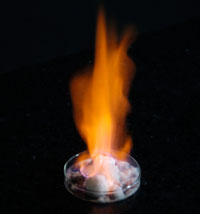- Kikawa
- That’s the reason the CHIKYU has been called a “floating laboratory,” isn’t it? The vessel is capable of keeping the cores at high pressures as they are directly taken from the high-pressure seafloor during their analysis on board, and these cores can be stored securely.
- Masuda
- In the eastern Nankai Trough, where the well is being drilled, ship operations can be difficult because of the strong currents.
- Kikawa
- The ability to operate in such conditions is one of the strengths of the CHIKYU. With its dynamic positioning system (DPS), it can continue drilling in the same place without being carried away by winds, waves, or the current.
- Masuda
- We are moving ahead with phase two of the MH21 project. Next year’s offshore production test will not only lead to extraction of methane hydrate resources soon, but we think it also represents a big step forward toward future commercial viability. Looking ahead, in addition to drilling we also hope to train personnel capable of handling a wide range of jobs related to marine resources.
- Kikawa
- At JAMSTEC we are also moving forward with scientific research on methane hydrate. Using the CHIKYU allows us to expand the range of our research on marine resources. Given this capability, we hope to create mechanisms that can effectively integrate the drilling technologies cultivated in oil drilling with the scientific knowledge obtained from scientific drilling. People with a wide array of skills will be needed to do this work, so we would love the people you have trained to actively participate in our project. Thank you for taking the time to talk with me today.

Submarine resources are gifts from the earth and sun

Burning “fire ice”— an artificial methane hydrate
Source: MH21 Research Consortium
Below the seafloor lie energy resources such as natural gas and methane hydrate, and mineral resources such as seafloor hydrothermal ore deposits, cobalt-rich crust, and manganese nodules. Energy resources derive from organic matter, produced through photosynthesis. They are truly gifts from the sun. Methane hydrate is very promising as a next-generation energy source. Mineral resources, in contrast, derive from non-organic matter produced within the earth’s interior. They can thus be called gifts from the earth. Seafloor hydrothermal ore deposits are formed by the sediments of useful metal components such as gold, silver, copper, and other rare metals that are dissolved in the hot water that erupts from the seafloor. The cobalt-rich manganese crust consists of ferromanganese oxide, which is almost like a covering on the seafloor. In addition to cobalt, the crust is thought to contain an abundance of platinum, rare metals, and rare earths. In the summer of 2011, it was reported that deep-sea sediment from the southeast and central regions of the Pacific Ocean, which appeared to be ordinary mud, actually contained high-quality rare earths. The deep-sea sediment used in this study included samples collected through the Ocean Drilling Program (ODP), the predecessor to the IODP.
